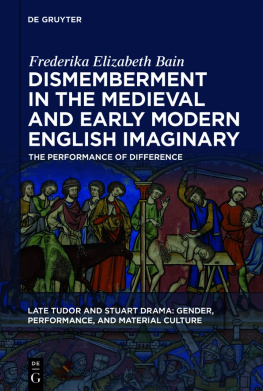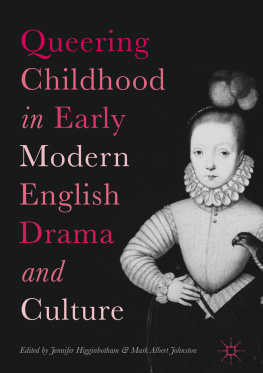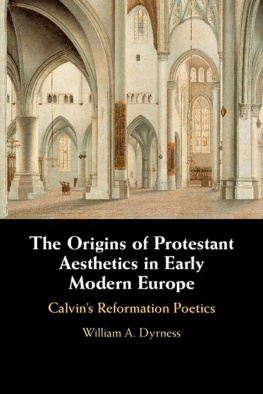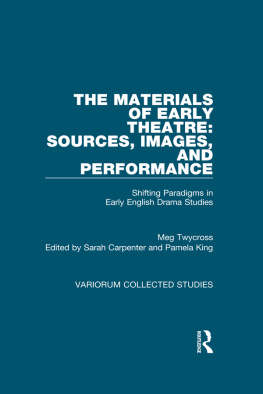DISMEMBERMENT
The Fragmented Body in Late Medieval and Early Modern Drama
Copyrighted image removed by Publisher
Margaret E. Owens
Stages of Dismemberment
The Fragmented Body in Late Medieval and Early Modern Drama
MARGARET E. OWENS
With a focus on visual representations of beheading, dismemberment, and mutilation in medieval and early modern drama, this study traces the impact of the Reformation on the semiotics of the body. What emerges from this exploration of violent spectacle is a sense of the complex and powerful ways in which the legacy of the pre-Reformation religious drama informed the commercial drama of the late sixteenth and early seventeenth centuries.
The proliferation of visual representations of violence in the early modern theater can be seen as continuous with the prominence that violent spectacle held in the earlier religious drama. Dismemberment and decapitation, as this study demonstrates, figured as standard types of stage spectacle from the fifteenth through to the early seventeenth centuries. This apparent continuity, however, obscures the profound rupture that intervened between the pre-Reformation and the Elizabethan theater, radically transforming the semiotic implications of staging dismemberment and decapitation. In pre-Reformation plays, the spectacle of dismemberment was subsumed within narrative and ideological paradigms that sought to reconcile fragmentation and unity. This drama of disintegration and reintegration was deeply implicated in the creation and transmission of histories that legitimated social institutions. With the Reformation and resulting secularization
(Continued on back flap)
STAGES OF DISMEMBERMENT
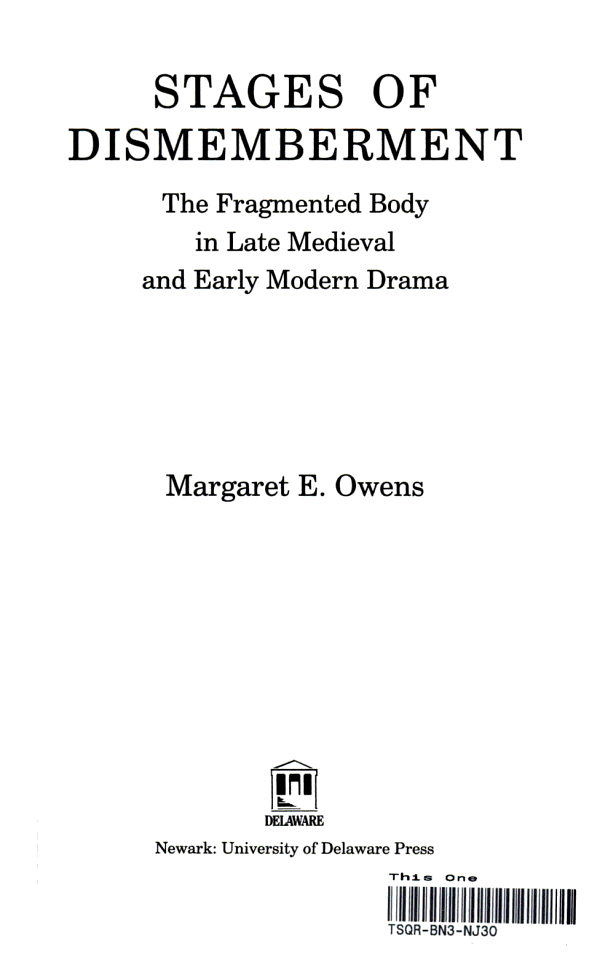
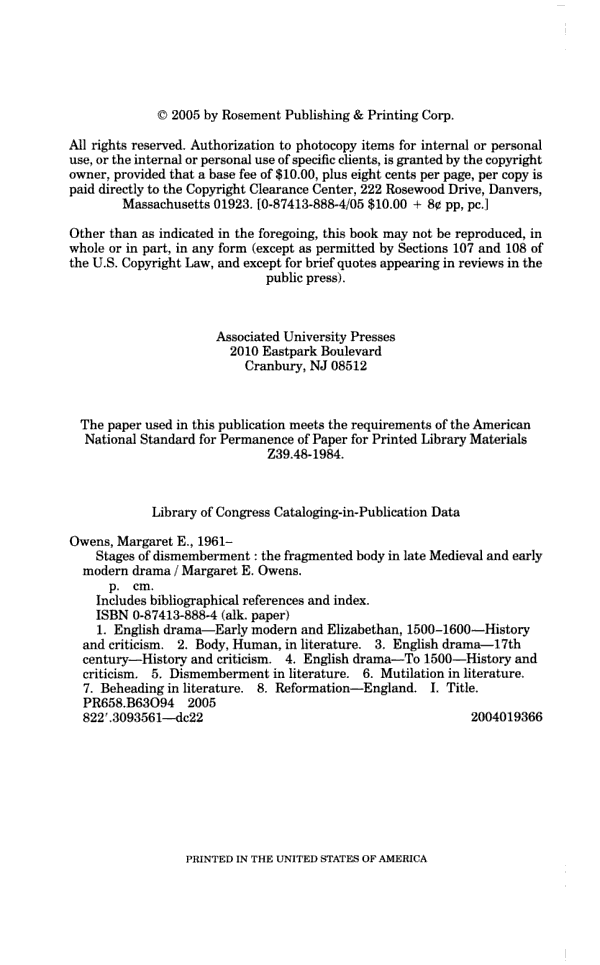
Acknowledgments
The INITIAL RESEARCH FOR THIS STUDY WAS FUNDED BY A DOCTORAL fellowship from the Social Sciences and Humanities Research Council of Canada. I am deeply grateful to Anne Lancashire for the acuity and generosity with which she oversaw the first stage of this project. The interest that many colleagues, friends, and conference participants have shown in my work over the years has proved crucial to helping me to bring this project to its completion. Given the subject matter of this book, I am almost hesitant to "name names"; however, Piet Defraeye, Randall Martin, and Roger Starling deserve special mention for providing intellectual and moral support. As well, I cannot resist this opportunity to acknowledge my undergraduate mentors, Zailig Pollock and Fred Tromly of Trent University, who first introduced me to the chiaroscuro of Renaissance literature.
An earlier version of Chapter 7 appeared as "The Many-Headed Monster in Henry VI, Part 2" in Criticism 38.3 (Summer 1996): 367-82. A version of Chapter 9 was published as "Desperate Juggling Knacks: The Rehearsal of the Grotesque in Doctor Faustus," in Medieval and Renaissance Drama in England 8 (1996): 63-93. I am grateful to the publishers for permission to make use of this material. For permission to reproduce illustrations, I would like to thank the Folger Shakespeare Library, the British Library, the Library of Congress, and Special Collections at the University of Virginia. It has been a pleasure to work with the staff at the University of Delaware Press and Associated University Presses, especially Christine Retz, who has efficiently moved the manuscript through the editorial process.
Finally, I arrive at the most personal expressions of appreciation. I am deeply indebted to my parents, William and Glenna Owens, who have not only tirelessly supported my scholarly work but also served as inspiring models of persistence, courage, and intellectual curiosity. I trust that my companion Tom Good has some sense of the incalculable ways in which he has contributed to the completion of this book. Nothing pleases me more than to express, in print, my thanks to my parents and to Tom.

Introduction
"There is something originally, inaugurally, profoundly wounded in the human relation to the world."
Jacques Lacan, The Ego in Freud's Theory and in the Technique of Psychoanalysis 1954-1955
"phantasies of dismemberment are a burden that all self-aware membered creatures bear and ... 'lines of fragilization' are drawn within the human body by all those who inhabit one"
Malcolm Bowie, Lacan
In 1992-93 THE MASSACHUSETTS INSTITUTE OF TECHNOLOGY LIST
Visual Arts Centre mounted an exhibit entitled Corporal Politics, featuring body-oriented work by eight artists. Among the works on display were Kiki Smith's bronze sculptures of male and female uro-genital systems, Robert Grober's wax replica of a man's leg severed below the knee, and an assemblage of phallic protuberances in black marble by Louise Bourgeois. In the exhibition catalogue, Helaine Posner, the curator, reflects on the timeliness of the exhibition's theme:
Corporal Politics examines a startling phenomenon in late-twentieth century art, the striking preponderance of the body fragment as a highly charged metaphor for the psychological, social, political, and physical assaults on the individual. The disturbing isolation of body parts and limbs, internal organs, and bodily fluids emphasizes the vulnerability of our bodies and implies physical violence, sexual oppression, and ultimate loss.1
The proliferation of images of dismemberment in contemporary art, Posner concludes, "is the result of living in a world in which violence, oppression, social injustice, and physical and psychological stress predominate. We may long for the secure ideals of beauty and wholeness embraced by past generations, but experi ence tells us that this worldview is obsolete.... Wholeness is compromised; the fragment is all."2 When precisely, we might wonder, did we lose our "secure ideals of beauty and wholeness"? Posner locates the shift from wholeness to fragmentation at the turn of the twentieth century, when "major advances in the natural sciences, psychology, sociology, and politics began radically to reshape the human psyche," giving impetus to an exploration of the motifs of fractures, fissures, and sutures in the works of the avant-garde from Rodin through the Cubists and the Surrealists.3 However, the lost age of wholeness recedes further into the past when we look at some of the cultural productions of Romanticism. Consider the figure that looms as the most enduring nightmare of that age, Mary Shelley's Creature, an assemblage of body parts stitched together from plundered corpses. If, as Posner asserts, images of dismemberment respond to the stresses of living with violence, oppression, and social injustice, it is no wonder that this motif should seem almost ubiquitous. After all, when and where did there exist a human society so blessed with universal harmony, justice, and prosperity, as to generate a corresponding art of wholeness?
According to Jacques Lacan, an almost crushing sense of our own fragmented condition is the price we pay for entry into subjectivity, into language (the Symbolic) and into human society. In his diagnosis, it is not a sickness in the social formation that generates nightmares of dismemberment but rather a woundedness that is constitutive of the human itself, to cite the passage from the Seminars that provides the first epigraph to this chapter. Although wary of essentialisms, I must confess that I find Lacan highly compelling in his portrait of the fragilized ego.4 A fascination with corporeal disintegration may very well constitute one of the few foundational and cross-cultural features of humanity. Fears about bodily integrity, after all, are metonymic for a fear of death, an undeniable universal.5


